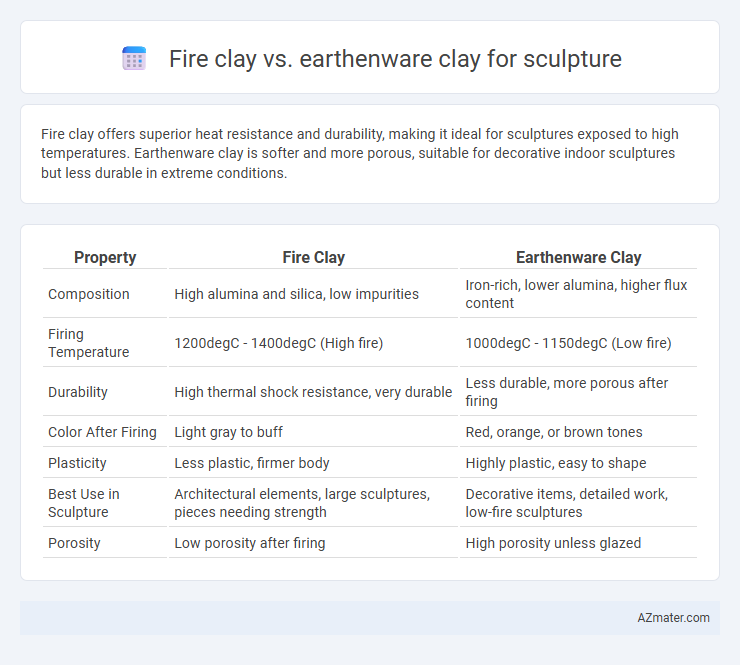Fire clay offers superior heat resistance and durability, making it ideal for sculptures exposed to high temperatures. Earthenware clay is softer and more porous, suitable for decorative indoor sculptures but less durable in extreme conditions.
Table of Comparison
| Property | Fire Clay | Earthenware Clay |
|---|---|---|
| Composition | High alumina and silica, low impurities | Iron-rich, lower alumina, higher flux content |
| Firing Temperature | 1200degC - 1400degC (High fire) | 1000degC - 1150degC (Low fire) |
| Durability | High thermal shock resistance, very durable | Less durable, more porous after firing |
| Color After Firing | Light gray to buff | Red, orange, or brown tones |
| Plasticity | Less plastic, firmer body | Highly plastic, easy to shape |
| Best Use in Sculpture | Architectural elements, large sculptures, pieces needing strength | Decorative items, detailed work, low-fire sculptures |
| Porosity | Low porosity after firing | High porosity unless glazed |
Introduction to Fire Clay and Earthenware Clay
Fire clay is a highly refractory material known for its exceptional heat resistance and durability, making it ideal for sculptors working on pieces exposed to high temperatures or requiring structural strength. Earthenware clay, in contrast, is a porous and softer clay body that fires at lower temperatures and is favored for its ease of shaping and rich, warm colors. Understanding the properties of fire clay and earthenware clay helps sculptors choose the right medium for durability, finish, and firing requirements in their ceramic artworks.
Composition and Properties of Fire Clay
Fire clay is composed primarily of alumina and silica, providing exceptional heat resistance and durability, making it ideal for high-temperature applications in sculpture. It exhibits low shrinkage and high plasticity, allowing for detailed shaping and reducing the risk of cracking during firing. In contrast, earthenware clay contains more impurities and has lower firing temperatures, resulting in a more porous and less durable final product suitable for decorative sculptures rather than structural or thermal stress applications.
Characteristics of Earthenware Clay
Earthenware clay is a porous, low-fire ceramic material typically fired between 1,000degC and 1,150degC, which makes it more porous and less durable than fire clay. It contains a higher amount of iron and other impurities, resulting in a reddish or brownish color and a softer texture that can be easily carved or shaped for detailed sculptural work. Earthenware clay's ease of manipulation and ability to hold intricate surface textures make it ideal for decorative sculptures, although it requires careful handling and sealing due to its absorbent nature.
Workability: Sculpting with Fire Clay vs Earthenware
Fire clay offers superior workability for sculptors due to its high plasticity and ability to retain fine detail without cracking during shaping. Earthenware clay, while softer and easier to manipulate initially, can be less structurally stable and more prone to deformation or shrinkage during drying. Choosing fire clay enhances precision and durability in sculptural work, especially for intricate or large-scale pieces requiring robustness.
Firing Temperatures and Techniques
Fire clay is prized in sculpture for its high firing temperature, typically between 1200degC to 1400degC, allowing for increased durability and resistance to thermal shock, making it suitable for functional and outdoor pieces. Earthenware clay, firing at lower temperatures around 1000degC to 1150degC, results in a more porous and less vitrified material that is often favored for decorative sculptures due to its rich color palette and ease of glazing. Techniques for fire clay require precise kiln control to achieve full maturation without warping, while earthenware benefits from oxidation or reduction atmospheres to enhance surface effects and color variations.
Surface Texture and Finish Comparison
Fire clay offers a dense, coarse surface texture ideal for robust sculptures requiring high durability and minimal shrinkage during firing. Earthenware clay provides a softer, more porous finish, allowing for finer detailing but tends to be less durable and more prone to surface cracks. Surface finish on fire clay results in a matte, rugged appearance, while earthenware clay can achieve smoother, more refined finishes with vibrant glazes.
Durability and Longevity of Sculptures
Fire clay offers superior durability and heat resistance compared to earthenware clay, making it ideal for sculptures exposed to high temperatures or outdoor conditions. Earthenware clay is more porous and prone to chipping and weathering, reducing the longevity of sculptures without proper glazing or sealing. Sculptors seeking long-lasting, robust pieces often prefer fire clay due to its enhanced structural integrity and longevity.
Color Range and Artistic Effects
Fire clay offers a limited color range, typically natural earthy tones like gray, beige, and brown, which enhance the rustic and organic appearance of sculptures. Earthenware clay, available in a broader spectrum of colors including reds, browns, and whites, allows artists to achieve vibrant and diverse artistic effects without relying solely on glazes. The color properties of earthenware provide greater versatility for expressive finishes, while fire clay's subtle hues contribute to a more subdued, textural aesthetic in sculptural works.
Cost and Availability for Artists
Fire clay offers higher temperature resistance and durability, making it suitable for intricate sculptures but comes at a higher price point compared to earthenware clay. Earthenware clay is more affordable and widely accessible, favored by artists for its ease of use and availability in most art supply stores. Artists on a budget or seeking readily available materials often prefer earthenware, while those requiring specialized properties invest in fire clay despite its cost.
Choosing the Right Clay for Your Sculpture Project
Fire clay offers high heat resistance and durability, making it ideal for sculptures intended to withstand extreme temperatures or outdoor conditions. Earthenware clay, with its porous and softer nature, is easier to mold and perfect for detailed or indoor decorative sculptures. Selecting the right clay depends on the sculpture's purpose, desired finish, and environmental exposure, where fire clay suits functional, heat-resistant pieces and earthenware excels in artistic flexibility.

Infographic: Fire clay vs Earthenware clay for Sculpture
 azmater.com
azmater.com